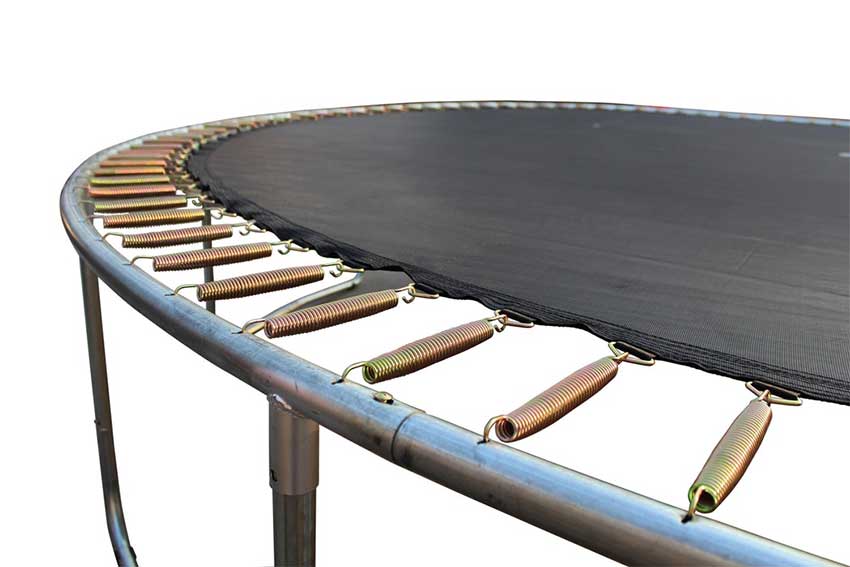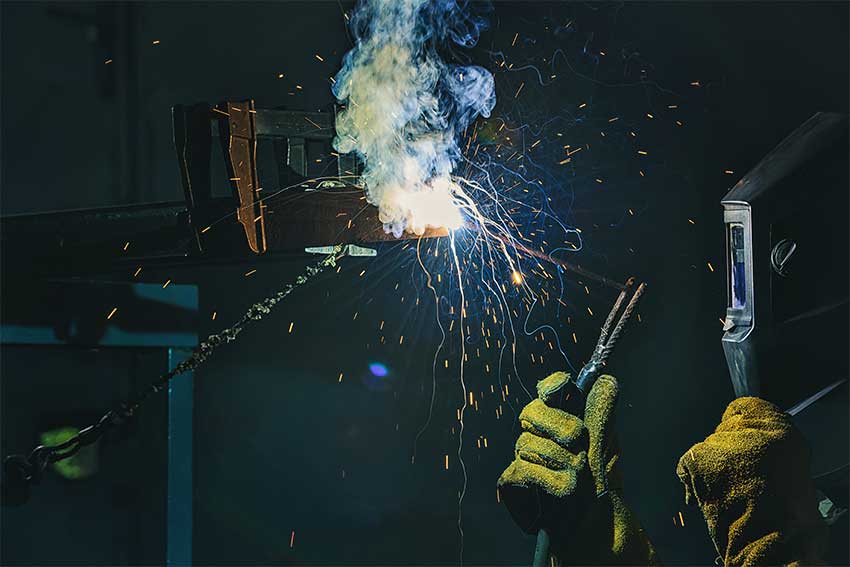Last Updated on October 5, 2023
Trampolines are made up of four fundamental parts: tubing, springs, jumping mat or canvas fabric, and safety pads. All of the components are specially set up to make the trampoline extremely safe to use. When choosing the frame material, galvanized stainless steel is recommended since it will assist to maintain your trampoline robust and sturdy throughout and after usage.
Although the basic trampoline is made up of only a few components, those who have sophisticated features such as basketball nets, trampoline ladders, and so on may have a more difficult time obtaining the finest quality parts available for their trampoline.
What are Trampolines Made of?

The main components of a trampoline, combined that a trampoline is made of:
- Tubing
- Spring
- Jumping mat or Canvas Fabric
- Safety pads
Table of Contents
Tubing for Trampoline Structure

The structure and legs of the trampoline are made of tubing. The size of the tubing varies based on the trampoline model. As you can see, trampolines come in a wide range of sizes, from personal fitness trampolines to big indoor trampolines.
The tubing will be cut in various diameters depending on the function of the trampoline. Even though tubing diameters vary, all components are galvanized. As previously said, galvanizing steel tubes protect the metal against corrosion or degradation. This is a component that, while typically sturdy, must be constantly checked and examined.
The frame is constructed of galvanized rust-resistant steel. This is done to make it both sturdy and capable of being outside during rainstorms. The frame of your trampoline is what allows you to stand lifted onto the mat in the first place, and it also serves as the foundation of your trampoline’s stability.
The trampoline frame is one of the most long-lasting and sturdy parts of the trampoline. Although you will most likely be good at utilizing it for the duration of the trampoline’s life, it is still necessary to ensure that the trampoline’s frame is kept up to date and is placed on a firm piece of ground that does not allow it to flex or get unstable support.
Spring Details for a Whole Trampoline
Spring is one of the most crucial components of a trampoline. The springs, in case you didn’t know, are what allow you to bounce up and down the trampoline. Several springs are generally carefully placed between the frame and the mat in high-quality trampolines.
The trampoline bounce is provided by the springs, not the canvas surface. Contrary to popular belief, the springs are responsible for the exertion you feel when thrown into the air. The spring’s strength, on the other hand, is determined by five criteria.
- Galvanization
- Material
- Size
- Number
- Shape
However, instead of employing springs, some springless models rely on elastic bands, which, while providing a similar bouncing motion, are typically less durable since their elasticity wears down over time. The springs are composed of rust-resistant steel that is commonly galvanized for increased strength and longevity.

The rust-resistant steel increases the trampoline’s longevity and usage because it can be placed outside without worrying about rain or humid conditions. If you need to change springs, it is best to go with long coil springs since they allow for more recoil than short coil springs.
Other parameters that influence trampoline spring efficiency include size, number, and form. When it comes to design, tapered springs are preferred since they give users more lateral stability while on the trampoline.
Galvanization: Galvanization is the process of coating a spring with a protective layer of zinc layers. Zinc is far more corrosion-resistant than metals such as steel. By zinc-coating, the springs manufacturers can assure that the spring will last for an extended amount of time.
Material: The material of the spring has a direct impact on the power of the springs. Almost all trampolines are made of metal. Some backyard trampolines make use of elastic bands to produce spring. Elastic bands, on the other hand, do not maintain tension and hence lose bounce potential with time.
Size: The size of the springs affects the trampoline’s buoyancy. The more force that can be applied to optimize the height of a bounce, the longer the spring.
Number: The amount of springs has a direct impact on the comfort and performance of a trampoline. The more springs there are, the easier it is to distribute weight and provide force.
Shape: Tapered springs are commonly utilized in the construction of trampolines. These springs are more costly than regular springs, but they are of higher quality. Tapered springs give better lateral stability to the jumper.
Jumping Mat or Canvas Fabric (Important Trampoline Material)

The jumping mat or canvas fabric, which is often composed of polypropylene or nylon material, is a crucial component of the trampoline since it supports the user’s weight when jumping and landing. When worn outside, the densely woven fabric is WV-protected to prevent fading.
Contrary to common perception, the mat does not cause the bouncing action; rather, it only creates a solid and powerful enough landing surface. The jumping mat is normally attached to the frame so that the user may bounce up and down without fear of falling. It is best to get a big mat consisting of well-knit nylon or polyethylene fibers for wide-scale application.
When it comes to trampolines, always choose robust jumping mats because they play a significant role in deciding the durability of your recreational item. Because the enjoyment of trampolines is derived from jumping on the surface frequently, it is important to select soft and smooth jumping material.
Poles

Poles are used to hold the enclosure net with a trampoline. For larger trampolines, poles are an essential element. Like frames and legs, they are made of heavy-duty galvanized steel.
Safety Pads
Safety pads are placed over the springs and frame. To link the cushions to the frame, they feature vinyl coverings and pie straps. The foam core of the safety pads is likewise outsourced and manufactured to manufacturer standards.
The value of trampoline safety pads cannot be emphasized, especially given their role in reducing trampoline-related injuries. The pads are often installed on both the frame and the springs. The safety pads include plush foam-filled vinyl coverings to increase their effectiveness in avoiding injuries.
The density of the foam varies based on the kind, use, and manufacturer of the trampoline. The purpose of safety pads is to cushion the landing impact and allow for smooth leaping and landing on the trampoline surface. When it comes to trampolines with robust, solid frames designed for large-scale use, high-density pads are always recommended.
Although safety pads are not regarded as a must-have for trampolines, it is recommended to invest in high-density foams that will ensure safety during use, especially if landing on the frame or springs. Safety nets are also utilized to make trampolines safer, when dealing with users who can easily land beyond the mat, such as youngsters.
Polyester, polypropylene, or polyethylene are the most common materials used to make safety nets. Polyethylene safety nets, on the other hand, are widely used because of their greater density and tensile strength.
Additional Equipment or Parts of a Trampoline

Safety Enclosures
Safety enclosures are made from two different materials. The first is Polyethylene, a thermoplastic that is both strong and safe. The other substance is often polyester, and both are derived from petroleum.
The key to having these nets last as long as possible around your trampoline is to make sure they are well-made and have a high-quality UV-protecting coating. If not, you will have to replace the safety enclosure more frequently than you would want.
Trampoline Ladder
A trampoline ladder is an additional equipment for the formation of a trampoline. Though it’s not a manufacturing part of a trampoline, a trampoline ladder is the must tool for the package of a trampoline.
Basketball Hoop

When trampoline users wish to utilize their trampoline for both trampolining and basketball, an additional apparatus, the basketball hoop, is required.
Wind Stakes
You might need trampoline wind stakes or an anchor kit to protect trampolines from flying away. Some trampolines come with these or you have to buy them separately to secure the trampoline in the ground.
Manufacturing Process of a Trampoline (What are Trampolines Made of)
Trampolines are typically constructed from the frame up. A manufacturer must choose the optimum frame material based on the proposed trampoline design. The tubing is bent into an arc on the flexural jig when it arrives at the trampoline manufacturer.
For the springs, holes are drilled through the sidewalls. Welded sockets allow the U-shaped legs to fit into the frame. Tubing is frequently sold in four parts. When all four are joined, they form a circular pattern. Each arc has one end swaged (squeezed down), so that the components may be assembled.
The cloth for the jumping mat is trimmed to size after it arrives at the mill. The cloth is bordered and reinforced web strapping is put on using industrial sewing machines. D-rings are stitched into the cloth to keep the mat in place on the frame.
To boost durability, a vinyl cover and pie straps are sewn around the foam core of the safety pads. There are no additional manufacturing procedures required at the facility for the springs. They are bundled with the other components for final shipment.
In the trampoline factory, it takes roughly 80 employees working an eight-hour shift to produce 500 to 600 trampolines.
Conclusion
To get the most value for your expenses on a trampoline, you must be quite picky about the material of your trampoline. You need to check out every piece of equipment which is being used in the installment of a trampoline. The tubing and spring will be galvanized and sturdy enough.
The finest mats are composed of polypropylene or nylon, which is flexible enough to stretch while maintaining a high degree of tension. The safety pads are vinyl coverings. All of these conditions of every piece of equipment will give the trampoline user a wonderful jumping experience on the trampoline floor.
As a result, now that you know more about the trampoline and its primary components, you should be in a better position to make the best option when it comes to acquiring or replacing it. Remember that the quality of a trampoline’s major components, not its size or shape, determines its quality. As a result, always double-check the quality of materials used to construct trampoline frames, jumping mats, and even springs.
Adam is not just a dad; he’s an adventure-seeking, outdoor-loving parent. When he’s not working, you’ll find him outdoors, enjoying the fresh air and bonding with his kids through sports and play.
Adam’s family-focused articles bring a unique perspective to trampoline jumping, emphasizing the importance of quality time and physical activity for children and adults alike.

